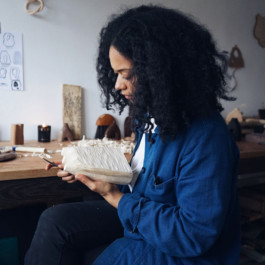There are many reasons to go tiny. Some do it to embrace minimalist habits and live more sustainably, while others seek location independence or a meaningful connection to nature. After all, sometimes a simple change of scenery is all you need to turn everything around – something we all learned the hard way this past year.
If you’re tinkering with the idea of pint-sized living, or have perhaps already made up your mind to make the leap (after taking our quiz, of course), the next step is to determine exactly what form your tiny dwelling will take. The options are endless, your imagination is the only limit – well that, and perhaps your budget. To get your creative juices flowing, we’ve rounded up 11 iconic types of tiny houses, complete with ingenious space-saving techniques and stylish interior designs. Who knows? You just might find the inspiration for your very own itty-bitty abode.
Tiny Trailer Home
If your house is going to be mini, it might as well be mobile, too! Digs on wheels are a favourite of tiny house enthusiasts and modern nomads the world over, offering freedom, independence and spontaneity with (quite literally) all the comforts of home. Though the concept of a tiny trailer home may seem indistinguishable from a camper trailer, the difference is marked: tiny homes are built for full-time living, generally outfitted with better insulation and a homelier ambience using higher-grade, often natural materials like wood to create a welcoming feel. The aesthetic possibilities are endless, with boxy modern styles appealing to many for their space-maximising shape and large window features. Stand-out examples include this luxe home with a rooftop deck, this shou sugi ban abode and this clean design featuring a library loft. We’re partial, however, to the cheek-pinching charm of tiny homes that look like mini versions of a traditional house, such as the one below. Just look at that miniature front porch!
Skoolie
If your motivation for going tiny is to see as much of this green earth as possible, then perhaps your tiny dwelling should come with its own motor. Converted school buses, or ‘skoolies’ for those in-the-know, are a popular nomadic living solution for the obvious reasons, but they also come with built-in affordability and sustainability cred in that they give new purpose to a disused yet resource-intensive commodity. Though overhauling an existing structure has its limitations, many skoolie transformations are truly incredible – like the portable home of travelling blogger family The Lost Bells (below), whose itinerant abode has lost any semblance of its former life. Rocking a totally different vibe, on the other hand, is this Aussie family’s skoolie, renovated and furnished almost entirely using found and reclaimed objects.
Tiny Ambulance House
Driving a bus-sized house comes with its challenges, of course. Tiny home dwellers looking for something more compact can consider a remodelled ambulance. With just enough space for a kitchen, bed and a bit of extra seating, an ambulance refurb won’t have as many bells and whistles as other tiny digs – and will only accommodate one or two people – but there’s still plenty of potential. Chris and Michelle, for instance, have turned their 4×4 rig into a real home, outfitted with beautiful details like navy blue cabinets, recessed lighting and a copper tile backsplash. They even use the exterior storage space to house their collapsible hot tub – as long as they’ve got a freshwater source, they’ve got a spa.
Horsebox House
Horse trailers aren’t usually top of mind when it comes to comfortable living, but where there’s a will, there’s a tiny house. You’ll find scores of great examples of horsebox conversions out there, however we’re particularly fond of the work by UK builders House-Box. Their off-grid tiny homes make ample use of wood and aged metals for a beautifully textured look – rustic yet equipped with high-tech luxuries, like a state-of-the-art audio system hidden in the ceiling. Idyllic country cabin living on wheels – who knew?
Yurt/Roundhouse
Perhaps the original tiny homes, yurts, roundhouses, teepees and other ancient, portable dwellings are having a moment. Here, YouTuber and unique Airbnb reviewer (dream job, anyone?!) Levi Kelly shows us around a lotus yurt in the Arizona desert just outside the Grand Canyon. With stylish, cosy accents and basic creature comforts, such as a small fridge and water kettle, the yurt is solar-powered and self-sustainable, making for an eco-friendly stay in a unique and breathtaking setting.
Tiny Houseboat
Who doesn’t dream of life on the water? Generally not very giant even in their full-sized form, houseboats are a natural fit for the tiny house movement. Check out this stunning 2-bedroom floating tiny home – and functional boat – created by Australian property expert and affordable housing advocate Ian Ugarte, in collaboration with architect Drew Heath. The houseboat’s defining feature is its breezy indoor-outdoor layout with movable walls – the inspiration for which Heath found in 18th-century Japanese brothel boat architecture. We can’t make this stuff up.
Tiny Narrowboat
Maybe open waters make you nervous, but you still long for the houseboat life: In that case, consider a narrowboat home like this 57-footer. Colin and Shaun of YouTube channel Foxes Afloat live year-round in their narrowboat Silver Fox, cruising the canals of the UK with their dog, Otis, while campaigning for mental health awareness. Below, they provide an entertaining tour of their slender abode with its off-grid accoutrements.
Tiny Treehouse
Perhaps it’s the immersion in nature, the joy of simplicity, or the sense of connecting with your inner child. Whatever it is, a love of treehouses is nearly universal. From that perspective, Pete Nelson – expert treehouse builder and host of TV show Treehouse Masters – is living the dream. Join him for a tour of one of the most enchanting treehouses at his bed and breakfast near Seattle, Washington. Curling around a Douglas fir, the tiny house exudes a rustic sense of whimsy throughout its compact yet warmly furnished spaces.
Tiny Earthship
Originally developed by architect Michael Reynolds in the ‘70s, an earthship is an off-the-grid home that’s made entirely of natural or repurposed materials, and is completely self-sufficient, from the water to the electricity and sewage – much like a sailboat or spaceship. This tiny earthship in Adelaide, Australia uses a patchwork of clever sustainable solutions to function passively and fully off-grid, from solar energy to grey water filtration, rainwater recycling and a natural cooling system. Highlights include the gorgeous and painstakingly laid bottle walls, as well as an indoor garden that’s perhaps the only place you can get freshly harvested bananas in winter in the Adelaide Hills!
Tiny Cob House
Another, more ancient alternative for eco-friendly living is a cob house, made from natural materials like clay, sand and straw. This stunning micro version, dubbed Hobbit Henge, was inspired by the work of artist and natural builder SunRay Kelley. The vaulted ceiling and outward-leaning walls provide a sense of spaciousness, while salvaged stained glass windows and swirling carvings infuse an element of fairy-tale fantasy reminiscent of Gaudí.
Converted Tiny House
Smaller living space, lower energy needs, less accumulation of things and products – tiny living encourages sustainability by its very nature. There are, however, ways to reduce your carbon footprint even further, such as by repurposing an existing structure to make your pint-sized house. From shipping containers to diesel tanks, concrete pipes and defunct railway carriages, you can turn just about anything into a tiny home. We love this silo conversion by architect Christoph Kaiser and stylist Shauna Thibault, who creatively overcame the challenges of maximising space in a curved capsule.














Sorry, the comment form is closed at this time.